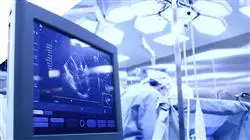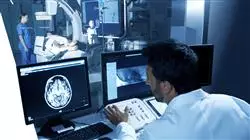University certificate
The world's largest faculty of nursing”
Introduction to the Program
Thanks to this Professional master’s degree you will learn about the advantages of E-Health and Big Data applied to the healthcare sector”

Although biomedicine is one of the most remarkable discoveries in the medical field, the truth is that new technologies have made it possible to implement informatics in patient rehabilitation processes. From the massive processing of data for research into rare diseases, to applications that allow the monitoring of patients with serious pathologies or even those that monitor blood sugar levels in patients with diabetes. These are advances that have brought significant improvements in the daily lives of those affected and also in their family environment.
The cost-effective and safe use of technologies, as designated by the WHO, is reflected in the concept of eHealth. Major scientific developments have also incorporated key tools for the development of healthcare treatments. Moreover, thanks to innovation in healthcare centers, it has been possible to improve clinical management and optimize healthcare services. TECH Global University's main objective is to boost the career of graduates who wish to increase their skills in the technological health service and are interested in the simultaneous development of telemedicine.
This program addresses the theoretical-practical foundations of modern medicine to generate a global and deep vision of the new biomedical incorporations. Additionally, this program delves into bioprinting, biomedical imaging and the possibilities offered by artificial intelligence in pattern recognition in medical images.
TECH Global University has proposed this study with the collaboration of expert teachers in the health area and, in addition, instruct the specialists with their real experiences in the field of action. This is an innovative and 100% online degree, which applies the Relearning, methodology, so that nurses do not have to spend long hours memorizing the syllabus, but are able to assimilate it in a progressive and simple way. All this, so that the specialist integrates the E-Health tools in his profession and collaborates in its development.
Don't wait any longer, distinguish yourself as a specialist in a sector that has already incorporated E-Health platforms to personalize the healthcare service”
This Professional master’s degree in E-Health and Big Data contains the most complete and up-to-date scientific program on the market. The most important features include:
- Practical cases presented by experts in Information and Communication Technology focused on the healthcare services
- The graphic, schematic, and practical contents with which they are created, provide scientific and practical information on the disciplines that are essential for professional practice
- Practical exercises where the self-assessment process can be carried out to improve learning
- Its special emphasis on innovative methodologies
- Theoretical lessons, questions to the expert, debate forums on controversial topics, and individual reflection assignments
- Content that is accessible from any fixed or portable device with an Internet connection
Boost your career thanks to bioinformatics computing and Big Data techniques, so that you master all fields of the healthcare area”
The program’s teaching staff includes professionals from the sector who contribute their work experience to this educational program, as well as renowned specialists from leading societies and prestigious universities.
Its multimedia content, developed with the latest educational technology, will allow professionals to learn in a contextual and situated learning environment, i.e., a simulated environment that will provide immersive education programmed to prepare in real situations.
The design of this program focuses on Problem-Based Learning, by means of which professionals must try to solve the different professional practice situations that are presented to them throughout the academic year. For this purpose students will be assisted by an innovative interactive video system developed by renowned experts.
With this program you will understand the importance of massive data processing against epidemiological diseases”

Join the change in eHealth by applying artificial intelligence and the Internet of Things (IoT) to telemedicine”
Syllabus
The syllabus of this Professional master’s degree in E-Health and Big Data has been developed by a team of experienced professionals in Health Sciences who will not only share their knowledge on the subject, but will also share their experience in the field to instruct specialists. Thanks to their contribution and the different audiovisual formats in which the contents are presented, students will learn in a dynamic and simple way about the healthcare system, molecular medicine, recognition through biomedical images and Big Data in medicine, among many other issues. For this purpose, TECH Global University applies the Relearning, methodology, which makes it possible to exempt specialists from long hours of memorization, assimilating the contents in a gradual and efficient manner.

Rely on an experienced teaching team in Health Sciences that will provide you with the keys to act in the healthcare field by applying E-Health”
Module 1. Molecular Medicine and Pathology Diagnosis
1.1. Molecular Medicine
1.1.1. Cellular and Molecular Biology. Cell Injury and Cell Death. Aging
1.1.2. Diseases Caused by Microorganisms and Host Defence
1.1.3. Autoimmune Diseases
1.1.4. Toxicological Diseases
1.1.5. Hypoxia Diseases
1.1.6. Diseases related to the Environment
1.1.7. Genetic Diseases and Epigenetics
1.1.8. Oncological Diseases
1.2. Circulatory System
1.2.1. Anatomy and Function
1.2.2. Myocardial Diseases and Heart Failure
1.2.3. Cardiac Rhythm Diseases
1.2.4. Valvular and Pericardial Diseases
1.2.5. Atherosclerosis, Arteriosclerosis and Arterial Hypertension
1.2.6. Peripheral Arterial and Venous Disease
1.2.7. Lymphatic Disease (Greatly Overlooked)
1.3. Respiratory Diseases
1.3.1. Anatomy and Function
1.3.2. Acute and Chronic Obstructive Pulmonary Diseases
1.3.3. Pleural and Mediastinal Diseases
1.3.4. Infectious Diseases of the Pulmonary Parenchyma and Bronchi
1.3.5. Pulmonary Circulation Diseases
1.4. Digestive System Diseases
1.4.1. Anatomy and Function
1.4.2. Digestive System, Nutrition, and Hydroelectrolyte Exchange
1.4.3. Gastroesophageal Diseases
1.4.4. Gastrointestinal Infectious Diseases
1.4.5. Liver and Biliary Tract Diseases
1.4.6. Pancreatic Diseases
1.4.7. Colon Diseases
1.5. Renal and Urinary Tract Diseases
1.5.1. Anatomy and Function
1.5.2. Kidney failure (Prerenal, Renal, and Postrenal). How they are triggered
1.5.3. Obstructive Urinary Tract Diseases
1.5.4. Sphincteric Insufficiency in the Urinary Tract
1.5.5. Nephrotic Syndrome and Nephritic Syndrome
1.6. Endocrine System Diseases
1.6.1. Anatomy and Function
1.6.2. The Menstrual Cycle and Associated Conditions
1.6.3. Thyroid Disease
1.6.4. Adrenal Insufficiency
1.6.5. Disorders of Sexual Differentiation
1.6.6. Hypothalamic-pituitary Axis, Calcium Metabolism, Vitamin D and its Effects on Growth and Bone System
1.7. Metabolism and Nutrition
1.7.1. Essential and Non-Essential Nutrients: Clarifying Definitions
1.7.2. Carbohydrate Metabolism and Alterations
1.7.3. Protein Metabolism and Alterations
1.7.4. Lipids Metabolism and Alterations
1.7.5. Iron Metabolism and Alterations
1.7.6. Disorders of Acid-Base Balance
1.7.7. Sodium and Potassium Metabolism and Alterations
1.7.8. Nutritional Diseases (Hypercaloric and Hypocaloric)
1.8. Hematologic Diseases
1.8.1. Anatomy and Function
1.8.2. Red Blood Cell Disorders
1.8.3. Diseases of White Blood Cells, Lymph Nodes and Spleen
1.8.4. Hemostasis and Bleeding Diseases
1.9. Musculoskeletal System Diseases
1.9.1. Anatomy and Function
1.9.2. Joints: Types and Function
1.9.3. Bone Regeneration
1.9.4. Normal and Pathological Skeletal System Development
1.9.5. Deformities of the Upper and Lower Limbs
1.9.6. Joint Pathology, Cartilage, and Synovial Fluid Analysis
1.9.7. Joint Diseases with Immunologic Origin
1.10. Nervous System Diseases
1.10.1. Anatomy and Function
1.10.2. Central and Peripheral Nervous System Development
1.10.3. Development of the Spine and Components
1.10.4. Cerebellum and Proprioceptive Diseases
1.10.5. Brain Disorders (Central Nervous System)
1.10.6. Spinal Cord and Cerebrospinal Fluid Diseases
1.10.7. Stenotic Diseases of the Peripheral Nervous System
1.10.8. Infectious Diseases of the Central Nervous System
1.10.9. Cerebrovascular Disease (Stenotic and Hemorrhagic)
Module 2. Health system Management and Administration in Health Centers
2.1. Healthcare Systems
2.1.1. Healthcare Systems
2.1.2. Healthcare Systems according to the WHO
2.1.3. Healthcare Context
2.2. Healthcare Models I. Bismark Model vs. Beveridge Model
2.2.1. Bismark Model
2.2.2. Beveridge Model
2.2.3. Bismark Model Beveridge Model
2.3. Healthcare Models II. Semashko, Private and Mixed Models
2.3.1. Semashko Model
2.3.2. Private Model
2.3.3. Mixed Models
2.4. The Health Market
2.4.1. The Health Market
2.4.2. Health Market Regulation and Limitations
2.4.3. Payment Methods for Doctors and Hospitals
2.4.4. Clinical Engineers
2.5. Hospitals. Typology
2.5.1. Hospital Architecture
2.5.2. Types of Hospitals
2.5.3. Hospital Organization
2.6. Health Metrics
2.6.1. Mortality
2.6.2. Morbidity
2.6.3. Healthy Life Years
2.7. Health Resource Allocation Methods
2.7.1. Lineal Programming
2.7.2. Maximization Models
2.7.3. Minimization Models
2.8. Measuring Healthcare Productivity
2.8.1. Measuring Health Productivity
2.8.2. Productivity Ratios
2.8.3. Input Adjustment
2.8.4. Output Adjustment
2.9. Health Process Improvement
2.9.1. Lean Management Process
2.9.2. Work Simplification Tools
2.9.3. Troubleshooting Tools
2.10. Healthcare Project Management
2.10.1. The Role Played by Project Managers
2.10.2. Team and Project Management Tools
2.10.3. Schedule and Time Management
Module 3. Research in Health Sciences
3.1. Scientific Research I. The Scientific Method
3.1.1. Scientific Research
3.1.2. Research in Health Sciences
3.1.3. The Scientific Method
3.2. Scientific Research II. Typology
3.2.1. Basic Research
3.2.2. Clinical Research
3.2.3. Translational Research
3.3. Evidence-Based Medicine
3.3.1. Evidence-Based Medicine
3.3.2. Principles of Evidence-Based Medicine
3.3.3. Methodology of Evidence-Based Medicine
3.4. Ethics and Legislation in Scientific Research. Declaration of Helsinki
3.4.1. The Ethics Committee
3.4.2. Declaration of Helsinki
3.4.3. Ethics in Health Sciences
3.5. Scientific Research Results
3.5.1. Methods
3.5.2. Rigor and Statistical Power
3.5.3. Scientific Results Validity
3.6. Public Communication
3.6.1. Scientific Societies
3.6.2. Scientific Conferences
3.6.3. Communication Structures
3.7. Funding in Scientific Research
3.7.1. Structure in Scientific Projects
3.7.2. Public Financing
3.7.3. Private and Industrial Funding
3.8. Scientific Resources in Literature Searching. Health Sciences Databases I
3.8.1. PubMed-Medline
3.8.2. Embase
3.8.3. WOS and JCR
3.8.4. Scopus and Scimago
3.8.5. Micromedex
3.8.6. MEDES
3.8.7. IBECS
3.8.8. LILACS
3.8.9. BDENF
3.8.10. Cuidatge
3.8.11. CINAHL
3.8.12. Cuiden Plus
3.8.13. Enfispo
3.8.14. NCBI (OMIM, TOXNET) and NIH (National Cancer Institute) Databases
3.9. Scientific Resources in Literature Searching. Health Sciences Databases II
3.9.1. NARIC - Rehabdata
3.9.2. PEDro
3.9.3. ASABE: Technical Library
3.9.4. CAB Abstracts
3.9.5. Centre for Reviews and Dissemination (CRD) Databases:
3.9.6. Biomed Central BMC
3.9.7. ClinicalTrials.gov
3.9.8. Clinical Trials Register
3.9.9. DOAJ- Directory of Open Access Journals
3.9.10. PROSPERO (Registro Internacional Prospectivo de Revisiones Sistemáticas)
3.9.11. TRIP
3.9.12. LILACS
3.9.13. NIH. Medical Library
3.9.14. Medline Plus
3.9.15. OPS
3.10. Scientific Resources in Literature Searching III. Search Engines and Platforms
3.10.1. Search Engines and Multisearch Engines
3.10.1.1. Findr
3.10.1.2. Dimensions
3.10.1.3. Google Scholar
3.10.1.4. Microsoft Academic
3.10.2. WHO International Clinical Trials Registration Platform (ICTRP)
3.10.2.1. PubMed Central PMC
3.10.2.1. Open Science Collector (RECOLECTA)
3.10.2.2. Zenodo
3.10.3. Doctoral Thesis Search Engines
3.10.3.1. DART-Europe
3.10.3.2. Dialnet
3.10.3.3. OATD (Open Access Theses and Dissertations)
3.10.3.4. TDR (Doctoral Theses Online)
3.10.3.5. TESEO
3.10.4. Bibliography Managers
3.10.4.1. Endnote Online
3.10.4.2. Mendeley
3.10.4.3. Zotero
3.10.4.4. Citeulike
3.10.4.5. Refworks
3.10.5. Digital Social Networks for Researchers
3.10.5.1. Scielo
3.10.5.2. Dialnet
3.10.5.3. Free Medical Journals
3.10.5.4. DOAJ
3.10.5.5. Open Science Directory
3.10.5.6. Redalyc
3.10.5.7. Academia.edu
3.10.5.8. Mendeley
3.10.5.9. ResearchGate
3.10.6. Social Web 2.0. Resources
3.10.6.1. Delicious
3.10.6.2. SlideShare
3.10.6.3. YouTube
3.10.6.4. Twitter
3.10.6.5. Health Science Blogs
3.10.6.6. Facebook
3.10.6.7. Evernote
3.10.6.8. Dropbox
3.10.6.9. Google Drive
3.10.7. Scientific Journal Publishers and Aggregators Portals
3.10.7.1. Science Direct
3.10.7.2. Ovid
3.10.7.3. Springer
3.10.7.4. Wiley
3.10.7.5. Proquest
3.10.7.6. Ebsco
3.10.7.7. BioMed Central
Module 4. Techniques, Recognition and Intervention using Biomedical Imaging
4.1. Medical Imaging
4.1.1. Modalities in Medical Imaging
4.1.2. Objectives in Medical Imaging Systems
4.1.3. Medical Imaging Storage Systems
4.2. Radiology
4.2.1. Imaging Method
4.2.2. Radiology Interpretation
4.2.3. Clinical Applications
4.3. Computed Tomography (CT)
4.3.1. Principle of Operation
4.3.2. Image Generation and Acquisition
4.3.3. Computerized Tomography. Typology
4.3.4. Clinical Applications
4.4. Magnetic Resonance Imaging (MRI)
4.4.1. Principle of Operation
4.4.2. Image Generation and Acquisition
4.4.3. Clinical Applications
4.5. Ultrasound: Ultrasound and Doppler Sonography
4.5.1. Principle of Operation
4.5.2. Image Generation and Acquisition
4.5.3. Typology
4.5.4. Clinical Applications
4.6. Nuclear medicine
4.6.1. Physiological Basis in Nuclear Studies. (Radiopharmaceuticals and Nuclear Medicine)
4.6.2. Image Generation and Acquisition
4.6.3. Types of Tests
4.6.3.1. Gammagraphy
4.6.3.2. SPECT
4.6.3.3. PET:
4.6.3.4. Clinical Applications
4.7. Image-Guided Interventions
4.7.1. Interventional Radiology
4.7.2. Interventional Radiology Objectives
4.7.3. Procedures
4.7.4. Advantages and Disadvantages
4.8. Image Quality
4.8.1. Technique
4.8.2. Contrast
4.8.3. Resolution
4.8.4. Noise
4.8.5. Distortion and Artifacts
4.9. Medical Imaging Tests. Biomedicine
4.9.1. Creating 3D Images
4.9.2. Biomodels
4.9.2.1. DICOM Standard
4.9.2.2. Clinical Applications
4.10. Radiological Protection
4.10.1. European Legislation Applicable to Radiology Services
4.10.2. Safety and Action Protocols
4.10.3. Radiological Waste Management
4.10.4. Radiological Protection
4.10.5. Care and Characteristics of Rooms
Module 5. Computation in Bioinformatics
5.1. Central Tenet in Bioinformatics and Computing. Current State
5.1.1. The Ideal Application in Bioinformatics
5.1.2. Parallel Developments in Molecular Biology and Computing
5.1.3. Dogma in Biology and Information Theory
5.1.4. Information Flows
5.2. Databases for Bioinformatics Computing
5.2.1. Database
5.2.2. Data management
5.2.3. Data Life Cycle in Bioinformatics
5.2.3.1. Use
5.2.3.2. Modifications
5.2.3.3. Archive
5.2.3.4. Reuse
5.2.3.5. Discarded
5.2.4. Database Technology in Bioinformatics
5.2.4.1. Architecture
5.2.4.2. Database Management
5.2.5. Interfaces for Bioinformatics Databases
5.3. Networks for Bioinformatics Computing
5.3.1. Communication Models. LAN, WAN, MAN and PAN Networks
5.3.2. Protocols and Data Transmission
5.3.3. Network Topologies
5.3.4. Datacenter Hardware for Computing
5.3.5. Security, Management and Implementation
5.4. Search Engines in Bioinformatics
5.4.1. Search Engines in Bioinformatics
5.4.2. Search Engine Processes and Technologies in Bioinformatics
5.4.3. Computational Models: Search and Approximation Algorithms
5.5. Data Display in Bioinformatics
5.5.1. Displaying Biological Sequences
5.5.2. Displaying Biological Structures
5.5.2.1. Visualization Tools
5.5.2.2. Rendering Tools
5.5.3. User Interface in Bioinformatics Applications
5.5.4. Information Architectures for Displays in Bioinformatics
5.6. Statistics for Computing
5.6.1. Statistical Concepts for Computing in Bioinformatics
5.6.2. Use Case: MARN Microarrays
5.6.3. Imperfect Data. Statistical Errors: Randomness, Approximation, Noise and Assumptions
5.6.4. Error Quantification: Precision and Sensitivity
5.6.5. Clustering and Classification
5.7. Data Mining
5.7.1. Mining and Data Computing Methods
5.7.2. Infrastructure for Data Mining and Computing
5.7.3. Pattern Discovery and Recognition
5.7.4. Machine Learning and New Tools
5.8. Genetic Pattern Matching
5.8.1. Genetic Pattern Matching
5.8.2. Computational Methods for Sequence Alignments
5.8.3. Pattern Matching Tools
5.9. Modelling and Simulation
5.9.1. Use in the Pharmaceutical Field: Drug Discovery
5.9.2. Protein Structure and Systems Biology
5.9.3. Available Tools and Future
5.10. Collaboration and Online Computing Projects
5.10.1. Grid Computing
5.10.2. Standards and Rules Uniformity, Consistency and Interoperability
5.10.3. Collaborative Computing Projects
Module 6. Biomedical Databases
6.1. Biomedical Databases
6.1.1. Biomedical Databases
6.1.2. Primary and Secondary Databases
6.1.3. Major Databases
6.2. DNA Databases
6.2.1. Genome Databases
6.2.2. Gene Databases
6.2.3. Mutations and Polymorphisms Databases
6.3. Protein Databases
6.3.1. Primary Sequence Databases
6.3.2. Secondary Sequence and Domain Databases
6.3.3. Macromolecular Structure Databases
6.4. Omics Projects Databases
6.4.1. Genomics Studies Databases
6.4.2. Transcriptomics Studies Databases
6.4.3. Proteomics Studies Databases
6.5. Genetic Diseases Databases. Personalized and Precision Medicine
6.5.1. Genetic Diseases Databases
6.5.2. Precision Medicine. The Need to Integrate Genetic Data
6.5.3. Extracting Data from OMIM
6.6. Self-Reported Patient Repositories
6.6.1. Secondary Data Use
6.6.2. Patients' Role in Deposited Data Management
6.6.3. Repositories of Self-Reported Questionnaires. Examples:
6.7. Elixir Open Databases
6.7.1. Elixir Open Databases
6.7.2. Databases Collected on the Elixir Platform
6.7.3. Criteria for Choosing between Databases
6.8. Adverse Drug Reactions (ADRs) Databases
6.8.1. Pharmacological Development Processes
6.8.2. Adverse Drug Reaction Reporting
6.8.3. Adverse Reaction Repositories at European and International Levels
6.9. Research Data Management Plans. Data to be Deposited in Public Databases
6.9.1. Data Management Plans
6.9.2. Data Custody in Research
6.9.3. Data Entry in Public Databases
6.10. Clinical Databases. Problems with Secondary Use of Health Data
6.10.1. Medical Record Repositories
6.10.2. Data Encryption
Module 7. Big Data in Medicine: Massive Medical Data Processing
7.1. Big Data in Biomedical Research
7.1.1. Data Generation in Biomedicine
7.1.2. High-Throughput Technology
7.1.3. Uses of High-Throughput Data. Hypotheses in the Age of Big Data
7.2. Data Pre-Processing in Big Data
7.2.1. Data Pre-Processing
7.2.2. Methods and Approaches
7.2.3. Problems with Data Pre-Processing in Big Data
7.3. Structural Genomics
7.3.1. Sequencing the Human Genome
7.3.2. Sequencing vs. Chips
7.3.3. Variant Discovery
7.4. Functional Genomics
7.4.1. Functional Notation
7.4.2. Mutation Risk Predictors
7.4.3. Association Studies in Genomics
7.5. Transcriptomics
7.5.1. Techniques to Obtain Massive Data in Transcriptomics: RNA-seq
7.5.2. Data Normalization in Transcriptomics
7.5.3. Differential Expression Studies
7.6. Interactomics and Epigenomics
7.6.1. The Role of Cromatine in Gene Expression
7.6.2. High-Throughput Studies in Interactomics
7.6.3. High-Throughput Studies in Epigenetics
7.7. Proteomics
7.7.1. Analysis of Mass Spectrometry Data
7.7.2. Post-Translational Modifications Study
7.7.3. Quantitative Proteomics
7.8. Enrichment and Clustering Techniques
7.8.1. Contextualizing Results
7.8.2. Clustering Algorithms in Omics Techniques
7.8.3. Repositories for Enrichment: Gene Ontology and KEGG
7.9. Applying Big Data to Public Health
7.9.1. Discovery of New Biomarkers and Therapeutic Targets
7.9.2. Risk Predictors
7.9.3. Personalized Medicine
7.10. Big Data Applied to Medicine
7.10.1. Potential for Diagnostic and Preventive Assistance
7.10.2. Use of Machine Learning Algorithms in Public Health
7.10.3. The Problem of Privacy
Module 8. Applications of Artificial Intelligence and the Internet of Things (IoT) in Telemedicine
8.1. E-Health Platforms. Personalizing Healthcare Services
8.1.1. E-Health Platform
8.1.2. Resources for E-Health Platforms
8.1.3. Digital Europe Program. Digital Europe-4-Health and Horizon Europe
8.2. Artificial Intelligence in the Healthcare Field I: New Solutions in Computer Applications
8.2.1. Remote Analysis of Results
8.2.2. Chatbox
8.2.3. Prevention and Real-Time Monitoring
8.2.4. Preventive and Personalized Medicine in Oncology
8.3. Artificial Intelligence in Healthcare II:
8.3.1. Monitoring Patients with Reduced Mobility
8.3.2. Cardiac Monitoring, Diabetes, Asthma
8.3.3. Health and Wellness Apps
8.3.3.1. Heart Rate Monitors
8.3.3.2. Blood Pressure Bracelets
8.3.4. Ethical Use of AI in the Medical Field. Data Protection
8.4. Artificial Intelligence Algorithms for Image Processing
8.4.1. Artificial Intelligence Algorithms for Image Handling
8.4.2. Image Diagnosis and Monitoring in Telemedicine
8.4.2.1. Melanoma Diagnosis
8.4.3. Limitations and Challenges in Image Processing in Telemedicine
8.5. Application Acceleration using Graphics Processing Units (GPU) in Medicine
8.5.1. Program Parallelization
8.5.2. GPU Operations
8.5.3. Application Acceleration using GPU in Medicine
8.6. Natural Language Processing (NLP) in Telemedicine
8.6.1. Text Processing in the Medical Field. Methodology
8.6.2. Natural Language Processing in Therapy and Medical Records
8.6.3. Limitations and Challenges in Natural Language Processing in Telemedicine
8.7. The Internet of Things (IoT) in Telemedicine. Applications
8.7.1. Monitoring Vital Signs. Wearables
8.7.1.1. Blood Pressure, Temperature, and Heart Rate
8.7.2. The IoT and Cloud Technology
8.7.2.1. Data Transmission to the Cloud
8.7.3. Self-Service Terminals
8.8. IoT in Patient Monitoring and Care
8.8.1. IoT Applications for Emergency Detection
8.8.2. The Internet of Things in Patient Rehabilitation
8.8.3. Artificial Intelligence Support in Victim Recognition and Rescue
8.9. Nanorobots. Typology
8.9.1. Nanotechnology
8.9.2. Types of Nanorobots
8.9.2.1. Assemblers. Applications
8.9.2.2. Self-Replicating. Applications
8.10. Artificial Intelligence in COVID-19 Control
8.10.1. COVID-19 and Telemedicine
8.10.2. Management and Communication of Breakthroughs and Outbreaks
8.10.3. Outbreak Prediction in Artificial Intelligence
Module 9. Telemedicine and Medical, Surgical and Biomechanical Devices
9.1. Telemedicine and Telehealth
9.1.1. Telemedicine as a Telehealth Service
9.1.2. Telemedicine
9.1.2.1. Telemedicine Objectives
9.1.2.2. Benefits and Limitations of Telemedicine
9.1.3. Digital Health. Technologies
9.2. Telemedicine Systems
9.2.1. Components in Telemedicine Systems
9.2.1.1. Personal
9.2.1.2. Technology
9.2.2. Information and Communication Technologies (ICT) in the Health Sector
9.2.2.1. t-Health
9.2.2.2. mHealth
9.2.2.3. u-Health
9.2.2.4. p-Health
9.2.3. Telemedicine Systems Assessment
9.3. Technology Infrastructure in Telemedicine
9.3.1. Public Switched Telephone Network (PSTN)
9.3.2. Satellite Networks
9.3.3. Integrated Services Digital Network (ISDN)
9.3.4. Wireless Technology
9.3.4.1. WAP. Wireless Application Protocol
9.3.4.2. Bluetooth
9.3.5. Microwave Connections
9.3.6. ATM Asynchronous Transfer Mode
9.4. Types of Telemedicine. Uses in Healthcare
9.4.1. Remote Patient Monitoring
9.4.2. Storage and Shipping Technologies
9.4.3. Interactive Telemedicine
9.5. Telemedicine: General Applications
9.5.1. Telecare
9.5.2. Telemonitoring
9.5.3. Telediagnostics
9.5.4. Teleeducation
9.5.5. Telemanagement
9.6. Telemedicine: Clinical Applications
9.6.1. Teleradiology
9.6.2. Teledermatology
9.6.3. Teleoncology
9.6.4. Telepsychiatry
9.6.5. Telehome-care
9.7. Smart Technologies and Care
9.7.1. Integrating Smart Homes
9.7.2. Digital Health to Improve Treatment
9.7.3. Telehealth Clothing Technology. “Smart Clothes”
9.8. Ethical and Legal Aspects of Telemedicine
9.8.1. Ethical Foundations
9.8.2. Common Regulatory Frameworks
9.8.4. ISO Standards
9.9. Telemedicine and Diagnostic, Surgical and Biomechanical Devices
9.9.1. Diagnostic Devices
9.9.2. Surgical Devices
9.9.2. Biomechanic Devices
9.10. Telemedicine and Medical Devices
9.10.1. Medical Devices
9.10.1.1. Mobile Medical Devices
9.10.1.2. Telemedicine Carts
9.10.1.3. Telemedicine Kiosks
9.10.1.4. Digital Cameras
9.10.1.5. Telemedicine Kit
9.10.1.6. Telemedicine Software
Module 10. Business Innovation and Entrepreneurship in E-Health
10.1. Entrepreneurship and Innovation
10.1.1. Innovation
10.1.2. Entrepreneurship
10.1.3. Startups
10.2. Entrepreneurship in E-Health
10.2.1. Innovative E-Health Market
10.2.2. Verticals in e-Health: mHealth
10.2.3. TeleHealth
10.3. Business Models I: First Stages in Entrepreneurship
10.3.1. Types of Business Models
10.3.1.1. Marketplaces
10.3.1.2. Digital Platforms
10.3.1.3. Saas
10.3.2. Critical Elements in the Initial Phase. The Business Idea
10.3.3. Common Mistakes in the First Stages of Entrepreneurship
10.4. Business Models II: Canvas Model
10.4.1. Canvas Business Model
10.4.2. Value proposition
10.4.3. Key Activities and Resources
10.4.4. Customer Segments
10.4.5. Customer Relationships
10.4.6. Distribution Channels
10.4.7. Partnerships
10.4.7.1. Cost Structure and Revenue Streams
10.5. Business Models III: Lean Startup Methodology
10.5.1. Create
10.5.2. Validate
10.5.3. Measure
10.5.4. Decide
10.6. Business Models IV: External, Strategic and Regulatory Analysis
10.6.1. Red Ocean and Blue Ocean Strategies
10.6.2. Value Curves
10.6.3. Applicable E-Health Regulations
10.7. Successful E-Health Models I: Knowing Before Innovating
10.7.1. Analysis of Successful E-Health Companies
10.7.2. Analysis of Company X
10.7.3. Analysis of Company Y
10.7.4. Analysis of Company Z
10.8. Successful E-Health Models II: Listening before Innovating
10.8.1. Practical Interview: e-Health Startup CEO
10.8.2. Practical Interview: "Sector X" Startup CEO
10.8.3. Practical Interview: "Startup X" Technical Management
10.9. Entrepreneurial Environment and Funding
10.9.1. Entrepreneur Ecosystems in the Health Sector
10.9.2. Financing
10.9.3. Funding
10.10. Practical Tools in Entrepreneurship and Innovation
10.10.1. Open-Source Intelligence (OSINT)
10.10.2. Analysis
10.10.3. No-Code Tools in Entrepreneurship

A program designed for professionals who want to master all the practical tools for entrepreneurship and innovation in their organization, someone like you”
Professional Master's Degree in E-Health and Big Data
The Professional Master's Degree in E-Health and Big Data is an academic program specializing in the integration and use of information technology in the world of healthcare. This Professional Master's Degree is designed for healthcare and informatics professionals who wish to enhance their understanding of this exciting and rapidly growing area. The healthcare industry is changing rapidly and innovators must be at the forefront of the evolution. This program explores the latest advances in information technology and how they are being used in healthcare. Students will learn the fundamentals of Big Data and data analytics and their practical application in healthcare. The goal of this Professional Master's Degree is to encourage the use of technological innovations in healthcare in order to improve the quality of patient care and achieve more efficient and cost-effective care. Participants will learn the fundamental concepts of medical informatics, including topics such as information security, decision making and project management.
Why study at TECH?
TECH Global University is ranked by Forbes as the best digital university in the world, thanks to its 10,000 university degrees in 10 different languages, many of them under 100% online modality so that more students in the world live the TECH experience. In short, the Professional Master's Degree in E-Health and Big Data is a challenging and innovative academic program that is designed to prepare students to work in the healthcare and information technology sector, fostering the use of emerging technologies to improve access and quality of healthcare. Enroll today and join the next generation of healthcare technology leaders!







